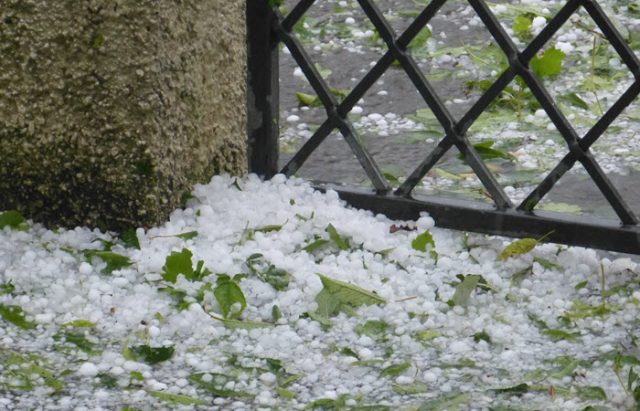How Tech Can Protect Your Home From Hail Damage
By Brian Wallace
April 4, 2019 • Fact checked by Dumb Little Man

In July 2010, an astonishingly large, naturally forming hailstone was recorded in the United States. At a weight of around 22 pounds, 19 inches in circumference, and 8 inches in diameter, though this stone was large, it was quite possibly one of many.
Sizes of hailstones vary from pea-sized to softball-sized. However, any hailstone over 1.5 inches is almost guaranteed to leave some damage behind. For an unprepared roof, hailstones like this are bad news.
Hail Happens – And It’s Getting Worse
Among some of the most unpredictable of weather events, hail can happen virtually anywhere by forming within the lower levels of thunderstorm clouds.
Heavy rain and variable winds keep moisture in the clouds, forming into water droplets that fuse and freeze together. They are kept afloat in the clouds by storm updraft.
Eventually, when the winds can no longer sustain the weight of the frozen pellets, they begin to fall to the ground unmelted.
Though bouts of hail usually don’t last longer than several minutes, the damage they can leave in their wake is serious. The worst part? It’s difficult to see them coming.
Hailstones may fall at speeds greater than 90 miles per hour.
High-velocity winds can make the trajectory of hailstones hard to predict and increase damage, thus making it difficult to insure.
Climate change is pushing risks of hail into Western and Northeastern states.
Across the United States, 2017 is *hailed* as one of the worst years for hail damage, resulting in 11 million affected properties and $1.7 billion in property damage. Damage in Texas alone made up $1.3 million of that damage. In some states, more than half of their properties were damaged by hail, 57% in Kansas, and 55% in Oklahoma.
Hail Damage Is Expensive

Nearly every state in the US has experienced at least one major hail storm and we aren’t the only ones. In 2017, extreme weather and its subsequent damage caused $330 billion in global property damage and over $135 billion in insurance paid claims.
Highly destructive and unpredictable weather events are increasing all over the world. In the last three decades, the average number of natural weather catastrophes increased by nearly 175%, hail storms hitting every seven to nine days.
In 1987, the average number of natural catastrophes was 490. Just last year, it was 850. Excluding Alaska, Rhode Island, and Hawaii, every state in the US has experienced threats and damage from falling hail.
Every year, hailstorms cause more than $10 billion in damage all across North America.
Damage Prevention And Early Detection Are Key
In terms of hail damage prevention, there’s currently only so much we can do.
For properties within areas that frequently see thunderstorms and hail, the right roofing material can go a long way. Consider 26 gauge roofing instead of standard asphalt shingles and inspect your roof regularly for damage.
After that point, it’s up to your insurance coverage to help protect your investment: your home.
Yet, compared to other types of weather damage, hail is tough to insure for. Giving consumers the right quotes takes a lot of data and reliable methods of both predicting risk and assessing the damage. Up until this point, this wasn’t always possible. Hail damage is difficult to address immediately and insurers may file claims months after the event itself.
Tech Is The Newest Solution
Further development with IoT and more emerging technologies are helping insurers and homeowners get a better idea of the regional risks for hail and other types of weather damage. As insurance agencies turn to remote AI monitoring of properties, surrounding weather, and incoming storms, homeowners are also utilizing personal home monitors to help detect and stop leaks.
At the end of the day, more and more consumers are getting the insurance coverage they need all the while educating themselves on the best practices for a truly hail-proof home.
From damaged crops to cars to properties to people, the forces of Mother Nature are unpredictable. And while we cannot stop the weather from hitting, we can be ready to withstand whatever comes at us.
See this infographic for more information on the increasing threats of hail damage, how technology is helping us see it coming, and what the next generation of weatherproofing looks like.
Please include attribution to WeatherCheck.co with this graphic.
Brian Wallace
Brian Wallace is the Founder and President of NowSourcing, an industry leading infographic design agency based in Louisville, KY and Cincinnati, OH which works with companies that range from startups to Fortune 500s. Brian also runs #LinkedInLocal events nationwide, and hosts the Next Action Podcast. Brian has been named a Google Small Business Advisor for 2016-present and joined the SXSW Advisory Board in 2019.



